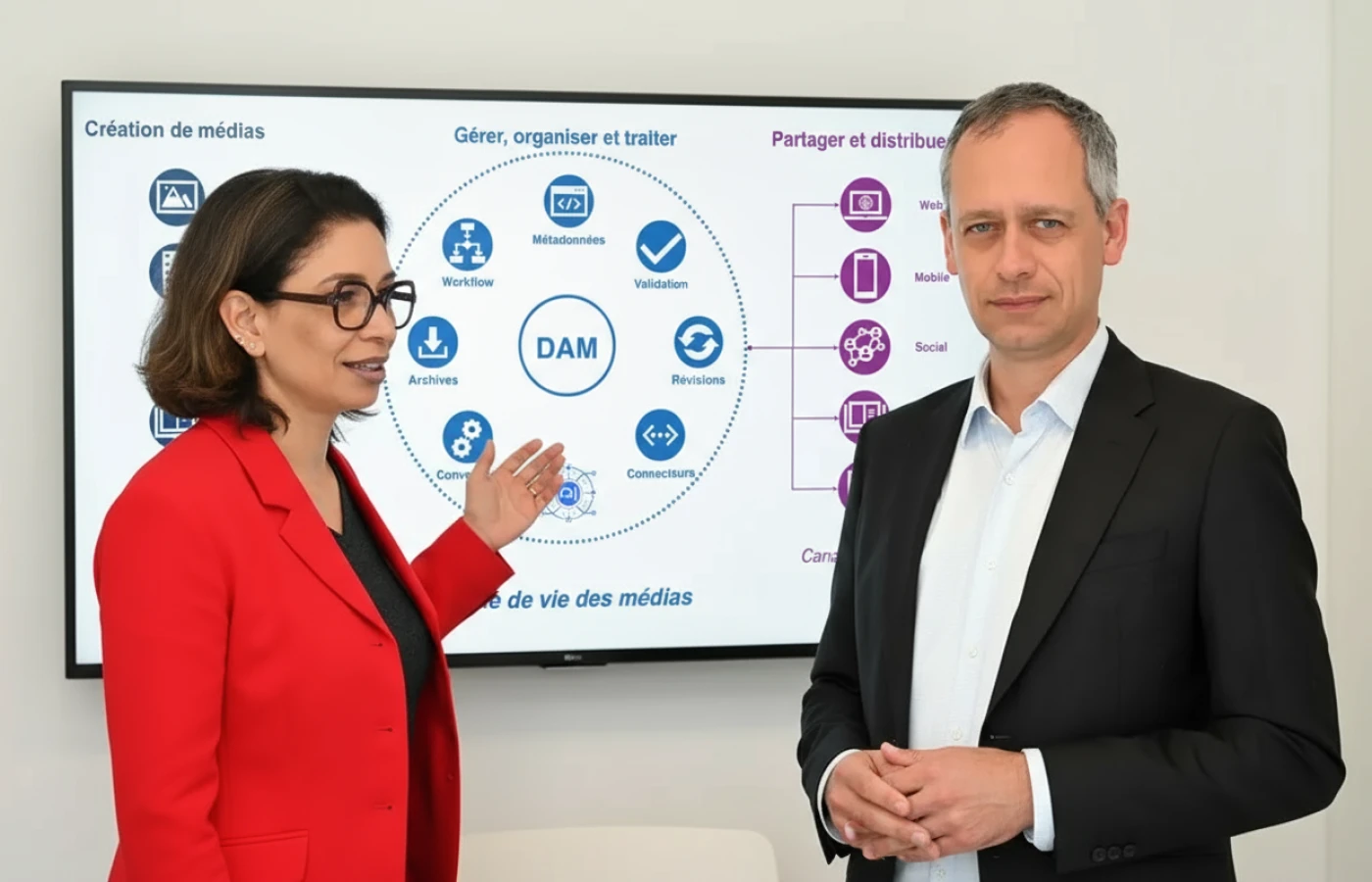
PIM manages product data while DAM handles rich media like images and videos. Integrating PIM and DAM creates a unified hub that streamlines product content across channels, enhances data quality, and accelerates content updates, delivering a consistent brand experience and faster time-to-market.
In the digital economy, the quality of product content plays a critical role in attracting, converting and retaining customers. Shoppers expect accurate product specifications, compelling images, videos, user manuals and rich storytelling across every channel. They want to trust that the product they see online will arrive exactly as described, and they rely on high‑quality visuals to make purchasing decisions without ever touching the item. For companies, managing this content at scale is challenging. Product information lives in spreadsheets, enterprise resource planning (ERP) systems and supplier databases. Images, videos and creative assets are scattered across file servers, email inboxes and cloud folders. Without a system to organize and connect this information, businesses struggle to deliver consistent, accurate and engaging product experiences.
Two software solutions have emerged to address these challenges: Product Information Management (PIM) and Digital Asset Management (DAM). A PIM system centralizes product data—names, descriptions, specifications, prices, SKUs, and other attributes—ensuring that every channel receives consistent, up‑to‑date information. A DAM system manages rich media assets such as images, videos, documents, graphics and audio files, making them searchable, secure and reusable. Individually, these systems provide significant benefits. Together, they create a powerful content engine that drives omnichannel success by aligning product data with the visuals and storytelling consumers demand.
This comprehensive guide explores the differences between PIM and DAM, explains why organizations need both, and provides a blueprint for integrating them effectively. You will learn how to choose integration models, overcome common challenges, implement metadata and governance frameworks, and evaluate which industries benefit most from a unified PIM‑DAM approach. We will also offer guidance on selecting PIM and DAM solutions that integrate seamlessly and provide criteria for assessing vendors. By the end, you will understand how bridging PIM and DAM creates a single source of truth for product content, accelerates time‑to‑market and delivers a superior customer experience.
A Product Information Management (PIM) system is a central repository for storing, managing and enriching product data. It acts as a single source of truth for all product‑related information used across channels—e‑commerce sites, marketplaces, mobile apps, print catalogs, point‑of‑sale systems, and internal platforms. PIM systems consolidate data from multiple sources, including ERP systems, suppliers and spreadsheets, and ensure that product information is accurate, complete and consistent. They support multiple languages, currencies and regional variations, enabling global organizations to manage product data for different markets.

Centralized Product Data Repository – PIM systems store all product attributes in a structured format. This includes basic information like product names, SKUs, descriptions and categories; technical specifications such as dimensions, weight and material composition; pricing and promotion data; shipping information; regulatory compliance details; and any custom attributes relevant to the business. By centralizing data, PIM eliminates the duplication and fragmentation that occur when information resides in disparate spreadsheets and databases.
Data Governance and Quality Management – PIM platforms enforce data quality through validation rules, completeness checks and workflows. They ensure that product records meet mandatory fields and formatting standards before being published. Governance features include role‑based permissions, audit trails, version control and approval workflows. These controls prevent unauthorized changes and ensure accountability.
Data Enrichment and Localization – PIM systems facilitate the enrichment of product data to make it more compelling and informative. Marketing teams can add marketing copy, key benefits, use cases and buyer personas. Localization features support translation into multiple languages, enabling global consistency while adapting to regional nuances. PIM also supports hierarchical structures, such as parent‑child relationships for product variants, kits or bundles.
Integration with Upstream and Downstream Systems – PIM connects to upstream sources like ERP and supply chain systems to ingest product data and updates. It also integrates with downstream systems such as e‑commerce platforms, marketplaces, print publishing software and mobile apps to distribute product information consistently. APIs and connectors facilitate real‑time synchronization and ensure that changes in the PIM automatically propagate across all channels.
Workflow Management – PIM platforms provide workflows to manage the product data lifecycle. Stakeholders—from product managers and merchandisers to legal and marketing teams—collaborate to create and approve product records. Workflow automation ensures that tasks are completed in sequence, deadlines are met and content is published only after approval.
Analytics and Reporting – PIM solutions often include reporting tools that monitor data quality, completeness and distribution performance. Teams can generate reports on missing attributes, translation readiness, channel readiness and product launch status. Analytics inform decision‑making, highlight bottlenecks and reveal areas for improvement.
Adopting a PIM system delivers significant value for organizations with large or growing product catalogs:
In summary, PIM systems organize product data, enforce data quality, support localization and streamline collaboration. They serve as the backbone for consistent and accurate product information across all channels.

Digital Asset Management (DAM) is a system designed to store, organize, manage and distribute digital media files—images, videos, audio recordings, documents, graphics, animations, presentations and more. A DAM acts as a central hub where organizations can easily find, reuse and repurpose digital assets. It provides robust search, metadata tagging, permissions, version control and workflows to ensure assets are used properly and stay up‑to‑date. DAM systems improve collaboration among creative teams, marketing departments, external agencies and other stakeholders who rely on digital content to execute campaigns and deliver engaging experiences.
Centralized Asset Repository – Similar to PIM, DAM systems store all digital assets in a single repository. Assets are organized into folders, collections or libraries, and associated with metadata for easy search and retrieval. Centralization ensures that employees and partners use the correct files, reducing duplication and inconsistency.
Metadata Tagging and Search – DAM platforms rely heavily on metadata to categorize and describe assets. Metadata fields include file type, keywords, product association, rights information, usage restrictions, creation date, creator and other custom attributes. Advanced search capabilities allow users to find assets by keyword, file type, color, orientation, date range, usage rights or other filters. Some DAMs leverage artificial intelligence to automate tagging by identifying objects, text and context in images and videos.
Version Control and Renditions – When an asset is updated or edited, a new version is created while preserving previous iterations. DAM systems track version history, allowing users to revert to earlier versions if needed. They also generate multiple renditions of the same asset—different file formats, sizes or resolutions—suitable for various channels such as web, print and mobile.
Permissions and Rights Management – DAM platforms allow administrators to define user roles (e.g., viewer, editor, administrator) and set granular permissions. Access can be restricted to specific assets, folders or collections. Rights management features track license expiration dates and usage rights, preventing unauthorized or out‑of‑scope usage.
Workflow Automation – A DAM supports workflows for asset ingestion, review, approval and distribution. When a new asset is uploaded, it may require approval from legal or brand managers before being available to the broader team. Workflows ensure that assets meet brand guidelines, licensing requirements and quality standards before publication.
Integration with Creative Tools and Systems – DAM systems integrate with creative suites (e.g., Adobe Creative Cloud), content management systems (CMS), social media publishing tools, marketing automation platforms, product information management (PIM) systems and e‑commerce platforms. Integration streamlines the flow of assets across the digital ecosystem and supports omnichannel content delivery.
Analytics and Reporting – DAM solutions provide insights into asset usage, including which files are most downloaded, who accesses them, and in what contexts they are used. This information helps organizations assess the ROI of content creation, identify popular assets, retire outdated files and plan future content needs.
Implementing a DAM solution yields numerous benefits for organizations that create and distribute digital content:

In essence, DAM systems streamline the management of digital assets, enhance search and collaboration, maintain brand consistency and integrate with marketing workflows. They empower organizations to deliver compelling visual content and stories that support product and brand experiences.
At first glance, PIM and DAM may seem similar—both manage content in a centralized repository and ensure consistency across channels. However, they serve distinct functions and focus on different types of information. Understanding these differences is crucial for appreciating why organizations need both systems.
Product Information vs. Rich Media – PIM systems handle product data: names, descriptions, SKUs, sizes, weights, prices, categories, technical specifications, and marketing copy. They ensure data accuracy, completeness and structure. DAM systems manage rich media assets: images, videos, documents, graphics, audio and animations. They focus on storing, organizing and distributing visual and multimedia content.
Data vs. Media – PIM deals with structured data that can be represented in tables, attributes and relationships. DAM deals with unstructured or binary media files that require metadata for categorization and retrieval.
Product Teams vs. Creative/Marketing Teams – PIM systems are often used by product managers, category managers, merchandisers and e‑commerce teams responsible for defining and maintaining product attributes and ensuring that data is accurate across channels. DAM systems are primarily used by marketing teams, designers, photographers, videographers and content creators who produce and manage visual and multimedia assets. However, cross‑functional collaboration is common, as product images and videos support product descriptions and marketing campaigns.
Data Governance vs. Brand Governance – PIM focuses on governing product data quality, ensuring each attribute is accurate, complete and consistent. DAM focuses on brand governance by managing visual identity, enforcing brand guidelines, controlling usage rights and maintaining a cohesive look and feel across assets.
Structured vs. Flexible Metadata – PIM uses structured data models with predefined attributes (e.g., price, weight, color). DAM uses flexible metadata to describe media assets (e.g., keywords, location, photographer, usage rights). DAM metadata structures are often customizable and can include hierarchical taxonomies and folksonomies.
Controlled Vocabularies vs. Creative Tagging – PIM often uses controlled vocabularies and classification schemes to ensure consistency. DAM encourages more expansive tagging (including AI‑generated tags) to capture creative context and enhance searchability.
Channel Syndication vs. Content Delivery – PIM systems syndicate product data to e‑commerce sites, marketplaces, print catalogs and other channels. They integrate with ERP, order management systems, and pricing engines. DAM systems deliver content to content management systems (CMS), marketing automation tools, social media platforms and creative applications. Integration points may overlap when PIM and DAM connect for product images, videos and other media.
Data Pipelines vs. Creative Pipelines – PIM pipelines handle updates to product data from suppliers, manufacturers and internal teams, applying validation rules and transformations. DAM pipelines handle creative workflows from asset creation and editing to approval and publication.
While PIM and DAM serve different functions, they complement each other. Product data is incomplete without high‑quality images, videos and documents. Visual assets are meaningless if not accurately associated with product information. By integrating PIM and DAM, organizations create a unified content ecosystem that delivers both accurate product data and compelling visual content. Each system excels at managing its respective content type, and integration ensures that product information and digital assets work together harmoniously.

In today’s omnichannel environment, delivering consistent product experiences across digital and physical touchpoints requires both rich product data and high‑quality visuals. Businesses that rely on separate systems or manual processes often face inefficiencies and inconsistencies. The combination of PIM and DAM addresses these challenges:
In short, organizations need both PIM and DAM to deliver accurate, enriched and visually compelling product content at scale. Together, they create a seamless content pipeline from product creation to customer engagement.
Integrating PIM and DAM requires thoughtful planning and execution. Several integration models exist, each with advantages and considerations. The right model depends on factors such as business goals, existing technology stack, data volume, performance requirements and IT resources.
In a linked integration model, PIM and DAM remain distinct systems connected via API calls. Each system maintains its own database and user interface. When a product record in the PIM is published or updated, the PIM references assets stored in the DAM by storing the asset IDs or URLs. When a user views the product record, the PIM retrieves the appropriate asset from the DAM on demand.
Advantages:
Considerations:
In this model, the DAM is embedded inside the PIM interface or vice versa. Users of the PIM see assets directly within product records, allowing them to search and associate assets without switching systems. A tighter integration may involve a unified user interface or a shared backend where product data and assets reside in a single platform.
Advantages:
Considerations:

A middleware solution acts as a bridge between PIM and DAM. An integration platform or enterprise service bus (ESB) orchestrates data flow, manages transformations and provides monitoring. Middleware can handle complex business logic, event triggers and synchronization of metadata between systems.
Advantages:
Considerations:
Some vendors offer a unified solution that combines PIM and DAM capabilities in one platform. The system provides a single interface, shared data model and integrated workflow engine. Unified platforms are designed to handle both product data and digital assets seamlessly.
Advantages:
Considerations:
In a composable architecture, both PIM and DAM are designed with APIs at the core. Each system exposes all functionalities through RESTful APIs, GraphQL endpoints or event‑driven messaging. An API gateway orchestrates calls between systems, and microservices handle specific tasks such as asset transformation or data validation. Frontend applications query the PIM and DAM directly via the APIs.
Advantages:
Considerations:
When choosing an integration model, organizations should assess their business requirements, existing systems, IT resources and long‑term vision. For some, a best‑of‑breed approach with middleware may offer flexibility and depth, while others may prefer a unified platform that simplifies adoption. API‑first integration is ideal for businesses embracing composable architectures and omnichannel delivery.

Integrating PIM and DAM is not just about connecting systems; it requires aligning metadata structures and governance frameworks. Without consistent metadata, product data and digital assets will not link correctly, leading to incorrect associations and search difficulties.
Define Standard Attributes – Identify key attributes that link product records to assets. Common attributes include SKU, product ID, variant ID, category, brand, lifecycle status, language, region and usage rights. Ensure that both PIM and DAM recognize these attributes and store them in a consistent format.
Use Taxonomies and Controlled Vocabularies – Create hierarchical taxonomies for product categories, asset types, themes and tags. Controlled vocabularies ensure that everyone uses the same terms, reducing ambiguity and improving search. For example, a taxonomy might include categories like "Electronics > Laptops > Gaming" and asset themes like "Lifestyle > Indoor" or "Lifestyle > Outdoor".
Leverage Metadata Standards – Standards such as IPTC (International Press Telecommunications Council) for photo metadata or Dublin Core for document metadata provide a base structure that can be extended. Adhering to standards improves interoperability with third‑party systems and partners.
Automate Metadata Assignment – PIM can automatically assign product IDs and categories to assets when they are associated. DAM systems can use AI to generate descriptive tags and extract information such as dominant colors, objects and scenes. Combining automated tagging with manual review ensures accuracy and efficiency.
Include Rights and Usage Metadata – Define fields that specify usage rights, expiration dates, license terms and compliance requirements. This metadata ensures that assets are used legally and within the boundaries of licensing agreements.
Role Definition and Access Control – Define roles and responsibilities for managing product data and assets. Establish who can create, edit, approve or publish content. Implement role‑based access control (RBAC) in both PIM and DAM systems to prevent unauthorized changes.
Approval Workflows – Build workflows that ensure both product data and assets are reviewed before publication. For example, a workflow might require product managers to approve data, brand managers to approve images and legal teams to approve compliance information. Integration should ensure that a product cannot be published until all associated assets have been approved.
Version Management – Implement version control for both product data and assets. When data changes (e.g., price updates) or new assets are uploaded (e.g., new product photos), previous versions should be retained for auditing and rollback.
Audit Trails and Reporting – Track changes to data and assets with audit logs. Reporting tools should highlight who made changes, when and why. This supports compliance, quality control and continuous improvement.
Data Stewardship – Assign data stewards or content owners who are responsible for maintaining data accuracy and completeness. They ensure that metadata standards are followed and governance policies are enforced.
Lifecycle Management – Define how long data and assets are retained, when they should be archived and when they should be retired. Lifecycle policies prevent clutter, reduce storage costs and ensure compliance with data retention regulations.
Effective metadata alignment and governance ensure that PIM and DAM work together seamlessly. They create a reliable foundation that enables automation, accurate associations and efficient search.

Although the benefits of integrating PIM and DAM are substantial, organizations may encounter challenges during planning, implementation and adoption. Understanding these challenges helps in developing strategies to mitigate them.
Mapping product data to assets can be complex, especially for businesses with large catalogs and variants. Products may have multiple images, videos and documents, and assets may apply to multiple products. Establishing consistent and accurate relationships requires careful planning, taxonomy development and metadata alignment.
Organizations often have legacy systems that store product data and assets. Migrating data and assets into modern PIM and DAM systems requires time, resources and coordination. Data may be incomplete, inconsistent or stored in formats that require cleaning and transformation. Overcoming silos involves change management, stakeholder engagement and technical migration expertise.
Integrating PIM and DAM with other enterprise systems—ERP, CMS, marketing automation, CRM, analytics—adds layers of complexity. Each integration requires API connections, data mapping, error handling and monitoring. Without careful design, integration projects can become costly and time‑consuming.
Employees may be accustomed to existing processes and reluctant to adopt new systems. Adequate training, user support and change management are essential for successful adoption. Users must understand the benefits of the unified PIM‑DAM approach and how it simplifies their work.
As product catalogs and media libraries grow, performance and scalability become critical. Slow loading times, search delays or integration bottlenecks can undermine user confidence. Systems must be architected to handle high volumes of data and concurrent users. Caching, indexing, load balancing and infrastructure planning are vital.
Maintaining metadata standards, updating taxonomies, managing user roles and enforcing approval workflows require continuous oversight. Without ongoing governance, systems can drift out of alignment, leading to inconsistent metadata and inaccurate associations. Assigning data stewards and implementing regular audits help maintain integrity.
By anticipating these challenges and planning accordingly, organizations can mitigate risks and ensure a smooth integration process.
While any organization selling products can benefit from PIM and DAM integration, certain industries derive exceptional value due to their reliance on rich product content and omnichannel delivery.
Retailers manage extensive product catalogs with thousands of SKUs, images, videos and detailed descriptions. They sell products across multiple channels—websites, mobile apps, marketplaces, social media and physical stores. Integrating PIM and DAM ensures consistent product information and visuals across channels, reducing customer confusion and returns. Retailers also benefit from faster seasonal launches, localized content and personalized merchandising.
Manufacturers produce complex products with technical specifications, assembly instructions, safety data sheets and 3D models. PIM ensures that all technical data is accurate and up‑to‑date, while DAM manages technical drawings, product images and instructional videos. Integration supports efficient communication with distributors, dealers and customers.
Technology products often have multiple variants, configurations and accessories. They require high‑quality images, demonstration videos, user manuals and compatibility charts. PIM manages detailed product attributes, while DAM ensures that images and videos reflect the latest features and design. Integration helps brands deliver engaging product pages and support materials.

Fashion retailers need to manage multiple product variants (sizes, colors, styles) and seasonal collections. High‑quality images, lookbooks, videos and lifestyle shots are essential for marketing. PIM organizes product attributes, while DAM stores and tags photoshoots and campaign assets. Integration enables consistent storytelling, faster lookbook creation and accurate sizing information across channels.
CPG companies manage nutritional information, ingredient lists, packaging designs, promotional videos and recipes. PIM ensures regulatory compliance by storing accurate nutritional data and ingredient details. DAM manages packaging artwork, advertising visuals and recipe images. Integration ensures that product pages and marketing campaigns align with regulatory requirements and brand identity.
Healthcare products and pharmaceuticals require precise product data, regulatory documentation, images of packaging, patient information leaflets and instructional videos. PIM manages drug specifications, dosage instructions and regulatory information. DAM stores packaging images, educational videos and marketing materials. Integration supports regulatory compliance and patient education.
Hotel chains and travel companies manage property descriptions, room types, amenities, pricing, promotional packages, images and videos. PIM organizes property data and availability, while DAM stores high‑quality images and virtual tours. Integration ensures consistent descriptions and visuals across booking platforms and marketing channels.
Automotive manufacturers and dealerships handle complex vehicle configurations, technical specifications, accessories, financing options and marketing materials. PIM manages vehicle data and pricing, while DAM stores images, videos and configuration tools. Integration ensures accurate product pages and immersive configurator experiences.
Across these industries, PIM and DAM integration supports accurate product information, engaging visuals, faster content creation, compliance and a better customer experience.
Choosing the right PIM and DAM solutions is critical for successful integration. Consider the following criteria when evaluating vendors:
Selecting PIM and DAM solutions that integrate effectively requires careful analysis of technical capabilities, business needs and future growth. Evaluating vendors against these criteria helps ensure a successful implementation and long‑term value.

Integrating PIM and DAM systems involves multiple stakeholders, technical considerations and process changes. The following best practices help ensure a successful implementation:
Following these best practices helps organizations integrate PIM and DAM effectively and realize the full value of unified product content.
The combination of Product Information Management (PIM) and Digital Asset Management (DAM) is no longer a luxury but a necessity for organizations seeking to thrive in the digital economy. PIM provides the structure and accuracy of product data, while DAM delivers the visual and multimedia richness that consumers expect. Individually, these systems are powerful. Together, they create a seamless content pipeline that improves data quality, accelerates time‑to‑market and delivers engaging experiences across all channels.
Understanding the differences between PIM and DAM—structured data versus rich media, product teams versus creative teams, data governance versus brand governance—clarifies why both systems are essential. Integration models range from loose coupling to unified platforms and API‑first architectures. The choice depends on business requirements, existing infrastructure and long‑term vision. Effective integration requires aligning metadata, implementing governance frameworks, addressing challenges such as data mapping and system silos, and adopting best practices for architecture, workflows and change management.
Industries such as retail, manufacturing, fashion, consumer goods, healthcare and automotive rely heavily on product content and therefore stand to benefit significantly from PIM‑DAM integration. When selecting solutions, organizations should evaluate integration capabilities, metadata flexibility, workflow tools, scalability, security and total cost of ownership. Choosing the right systems and implementing them thoughtfully ensures that product data and digital assets work in harmony.
As commerce continues to evolve across new channels and technologies, the need for unified product content will only grow. PIM and DAM integration equips organizations to meet this demand, delivering accurate, rich and engaging product experiences that build customer trust, drive sales and foster brand loyalty. By investing in a unified approach to product data and digital assets, companies position themselves to succeed in the competitive, omnichannel world.